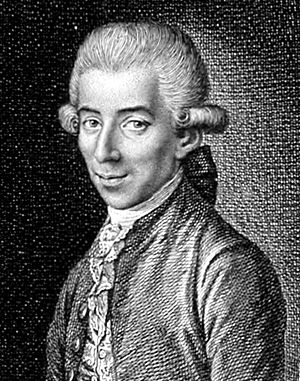Ignaz von Born facts for kids
Ignaz von Born (born 26 December 1742 in Alba Iulia, a region called Transylvania, part of the Habsburg monarchy at the time – died 24 July 1791 in Vienna) was a very important scientist. He studied mineralogy, which is the study of minerals, and metallurgy, which is about how to get metals from rocks and make them useful. He was a leading scientist in the Holy Roman Empire during the 1770s, a time known as the age of Enlightenment, when people focused on reason and science.
Ignaz von Born was interested in many things, including mining, minerals, ancient fossils (palaeontology), chemistry, how to work with metals, and even malacology, which is the study of snails and shells.
Contents
A Life of Learning and Discovery
Born came from a noble family in Transylvania. He started his education in his hometown. Later, he went to a Jesuit college in Vienna, but he left after a short time to study law at Prague University.
After his studies, he traveled a lot. He visited places in what are now Germany, the Netherlands, and France. During these travels, he learned more about minerals. When he returned to Prague in 1770, he started working in the department that managed mines and the making of coins.
In 1776, a powerful ruler named Maria Theresa of Austria asked him to organize the imperial museum in Vienna. This museum is now known as the Naturhistorisches Museum (Natural History Museum). He also became part of the council that oversaw mines and coin production. He lived in Vienna until he passed away.
Born developed a new way to get metals from ore using a process called amalgamation. This method helped make mining more efficient. He also made other improvements in mining and technical processes. He wrote several books, including Lithophylacium Bornianum and Bergbaukunde, and also created catalogues for museums.
Ideas and Influence
Ignaz von Born was also known for his writings. He tried to use satire, which is a way of using humor or exaggeration to criticize something. One of his works, Die Staatsperücke, criticized how the government worked. He also wrote a satire called Monachologia, where he described monks using scientific terms, almost like they were a new species.
Born was very good at Latin and other European languages. He knew a lot about many different scientific fields, not just metals and minerals. He was also involved in political changes in Hungary. After the death of emperor Joseph II, the Hungarian government honored Born for supporting their cause.
His scientific achievements were recognized internationally. In 1771, he became a member of the Royal Swedish Academy of Sciences, and in 1774, he became a Fellow of the Royal Society in London.
Planning a World Voyage
In 1781, Born suggested that Austria should send a scientific expedition around the world, similar to the famous voyages of Captain Cook. He hoped to lead this journey himself, but his health was not good enough. So, Franz Josef Maerter and Franz Boos went instead. Later, in 1789, Born recommended another scientist, Thaddaeus Haenke, for a Spanish expedition.
In 1790, Born created a detailed list of the mineral collection belonging to Éléonore de Raab. This work was so important that it was used as the basis for a new system of mineralogy by William Babington in 1799.
At the time of his death in 1791, he was writing a book called Fasti Leopoldini. This book was likely about the wise actions of Leopold II, Holy Roman Emperor, who became emperor after Joseph II.
Connection to Mozart
Born was also an active member of a group called the "Freemasons." He introduced and taught the famous composer Mozart about the Freemasons. Born's essay, Über die Mysterien der Ägypter (The Mysteries of the Egyptians), was published in a Freemason magazine in 1784. This essay was one of the inspirations for the story of Mozart's famous opera, The Magic Flute. Born was also a leader of a group called the Viennese Illuminati, and he supported the ideas of the Enlightenment.
Legacy
A mineral called bornite (Cu5FeS4), which is a common source of copper, was named in his honor. This shows how important his work in mineralogy was.
Publications
- Born, I. 1778. Index rerum naturalium Musei Cæsarei Vindobonensis. This book listed natural items from the Imperial Museum in Vienna.
Species He Described
Ignaz von Born described many new species of animals, especially snails and shells. Here are some examples:
- Bullata bullata (Born, 1778)
- Conus centurio Born, 1778
- Fissurella nodosa (Born, 1778)
- Patella miniata Born, 1778
- Semicassis granulata (Born, 1778)
- Vasum muricatum (Born, 1778)
He also described many types of bivalves (animals with two shells), such as:
- Argopecten nucleus (Born, 1778)
- Dosinia concentrica (Born, 1778)
- Mactra glauca Born, 1778
- Ostrea cristata Born, 1778
See also
- List of minerals named after people


